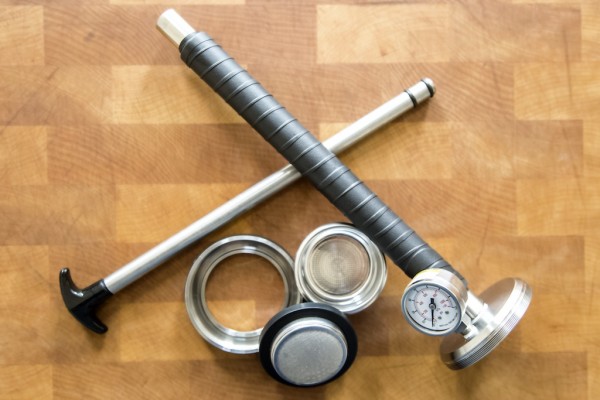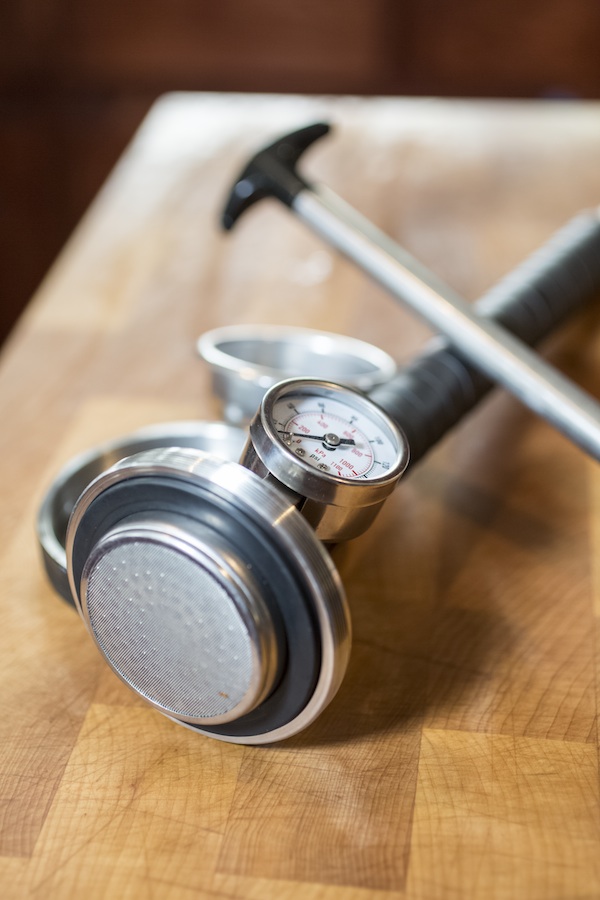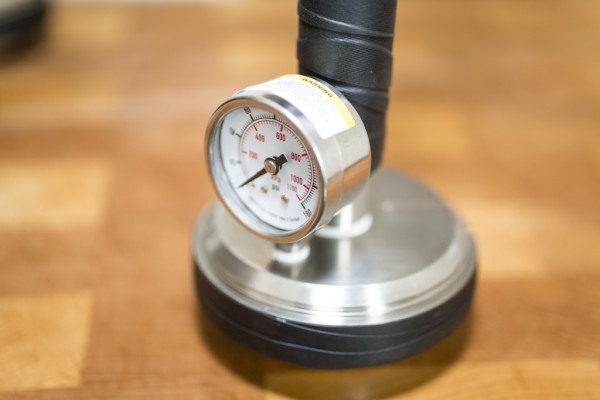The EspressoForge is a fascinating new arrival to the sparsely populated field of portable manual espresso equipment. It resembles a bicycle pump but is truly a hydraulic device, “pneumatic” only inasmuch as a tiny bit of air may incidentally get trapped at the top of the column.
It also shares a certain operating principle with the Aeropress, although it differs in that it actually achieves a goal to which the Aeropress only purports to aspire. The manually powered, solid 304 stainless steel piston directly forces water through a commercial-size 58-millimeter basket with easily enough pressure for a true espresso extraction. By monitoring the built-in manometer while adjusting one’s downward force, an experienced user can experiment with real-time pressure profiling either on the fly or according to a recipe. In form, function, and product development, as well, the EspressoForge stands alone.
Alone, that is, until you learn that the inventor, Andre Vornbrock, used the online coffee community Home-Barista.com as a public sounding board while finalizing the prototype and honing the production process. Vornbrock, 30, a Dallas-based web application programmer with a background in electrical engineering and building control systems, developed the EspressoForge on his own, in his spare time, in the suburban home he shares with his wife and 1-year-old daughter.
“The machine that I was thinking of was so simple,” Vornbrock told Daily Coffee News. “I thought to myself, how could it not work? I asked a few friends and a few people and they said well, the only way you’re ever really going to know is to build a prototype and see if it makes coffee.”
He built it, and it does.
One Man’s Crowded Collaboration
When La Marzocco or Nuova Simonelli introduces a new design or incorporates a new technology, it’s like thunder rolling down off Mt. Olympus. Fledgling designers and companies that take wing on the momentum of crowdfunding campaigns upend this traditional equation in an exciting way, although these projects just as often burn or fizzle out. Vornbrock and the EspressoForge remind us that individuals, too, with patience, passion, and realistic expectations, can make beautiful, effective, and lasting things. At the same time, even a lone wolf has much to gain in bouncing some ideas off the pack every once in a while.
By the bringing his idea to Home-Barista, Vornbrock was able not only to gauge the interest of his target demographic before deciding to proceed, but also to receive some valuable feedback and advice from a brain trust that includes more than a few serious coffee industry veterans. Also in the mix are some fellow engineers, craftspeople, scientists, and well-seasoned espresso enthusiasts. While much of their advice on technical matters turned out to be but nutritious food for thought, some of it did also have direct affects on the final product.
“It gave me direction,” says Vornbrock. “I think overall, that sounding-board advice and other things some of the members mentioned did contribute, but I don’t know if it was as much as it might have seemed online.”
Vornbrock cites the handle grip material as an example of an issue for which he received multiple suggestions, but wound up finding his own solution. The material for the two O-rings on the piston, meanwhile, was a suggestion from an H-B member that directly improved the performance of the machine.
Vornbrock first joined the online community in 2008 while living abroad in Israel and just starting to navigate the rabbit-hole of fine coffee at home. Over the years he graduated from a domestic La Pavoni manual lever machine to the vintage, obsolete Caravel manual lever machine (which has recently surged in popularity among aficionados), to finally a Bezzera Strega, which is among the top tier of home lever machines currently in production. He started designing the EspressoForge in earnest in Texas in December of 2014, aiming for not only a robust portable shot-puller — or pusher, as the case may be — but also as a simple and affordable means of experimenting with precise pressure profiling.
“I had perceived that the market on this type of device wasn’t necessarily going to be a mass market,” Vornbrock reflected in a recent phone conversation. “It was basically people that were already coffee enthusiasts, that already had at least an adequate, probably a very good grinder, experience making espresso on 58-millimeter commercial machines or with that type of basket, that basically just wanted that same type of thing either in a portable machine or just something simple that they could play around with pressure profiling without stepping up and buying a Vesuvius or Slayer.”
Conversations or Commerce
Though it could have gone either way, the underlying commercial potential of the project was evident enough that in February of 2015, Vornbrock first sought the permission of Home-Barista webmaster Dan Kehn to initiate his thread in the site’s general “Espresso Machines” forum rather than in the “Marketplace” forum, to which vendors are ordinarily restricted when it comes to information regarding products, sales, or other commercial endeavors. Kehn runs a tight ship, which is of particular importance for an online community where “upgrade-itus” runs rampant and much of the popular equipment isn’t cheap.
“The commercial posts rule is really about protecting the membership from constant sales pitches,” Kehn told Daily Coffee News in an email exchange. “Clearly Andre wasn’t motivated by profit, but personal interest in a project. If that doesn’t embody the purpose of an online community, I don’t know what does.”
Kehn also agreed that public projects such as the EspressoForge add a vitality and stimulation to Home-Barista discourse that is distinct from the community’s more predictable queries and solutions. “A lot of the discussions on HB are troubleshooting problems that have been resolved before, helping with buying advice, or sharing recommendations,” writes Kehn. “Projects from long-time members are more engaging and satisfying, since they have more depth and a genuine opportunity to advance the community knowledge — maybe even the industry.”
In the portable espresso-maker industry, the closest existing product to the EspressoForge is probably among the Rossa line of espresso-makers from the similarly tiny Australian company Portaspresso. However, while the Portaspresso designs are as elegant as they are stout, they are also over twice the price, and are harder to come by in the States.
In terms of EspressoForge’s self-determined business model, the handiest comparison would be to that of the Idaho-based manual grinder designers Orphan Espresso, whose products are also a fitting companion to the EspressoForge. The difference is that prior to designing grinders, OE had almost a decade of specializing in parts and service for vintage and obscure home espresso machines, garnering a sort of cult following among espresso aficionados. Vornbrock has no such background, although as a member of Home-Barista, he did have access to a good chunk of the following.
Vornbrock sees OE’s volume of sales as a benchmark for the EspressoForge’s potential. “I’d taken the Orphan Espresso model of how many grinders have they shipped,” says Vornbrock, “and applied that to how many devices would I likely ship, over the course of how many years. They haven’t shipped thousands and thousands of grinders, and it’s been over multiple years. Anybody that buys a Pharos would probably be interested in buying this.”
The pairing of an EspressoForge with an OE LIDO 3 manual grinder by Orphan Espresso seems so natural to Vornbrock that he has considered bringing the idea of a co-venture to the grinder-makers.
“I have no idea if they’d be into a grinder-and-machine partnership,” says Vornbrock. “I don’t know what it would look like, either.” One possibility could be a travel case that fits both the Forge and a LIDO. Another less committal idea is to at least coordinate retail presences on the web and on select real-life shelves. At this point the two companies have not communicated directly.
Slowly Forging Growth
For now, Vornbrock is content to ship the modest number of preorders he has received and let come what may from word of mouth and user-generated experience threads on sites like Home-Barista, CoffeeGeek, the Australian site CoffeeSnobs, and other communities. He has no current plans to advertise and no intention of launching a Kickstarter campaign. Rather than foist his product into the consideration of a largely inexperienced public, risking bad reviews and product returns, Vornbrock prefers the safer and more manageable model of letting the targeted demographic find the EspressoForge themselves, slowly and through their own trusted channels.
“Best case scenario, I guess, would be selling a lot of them,” Vornbrock says cautiously, noting that his current machinist could generate the custom parts by the thousands if demand was there. “But it takes an hour or two to assemble each of these by hand right now. That would be the main limiting factor.”
While operation of the EspressoForge is not difficult, best results from this or any manual espresso machine ultimately come with practice and experience. “My biggest fear would be people that buy the device but don’t have a realistic expectation of what it is,” says Vornbrock. “That’s why I’ve tried to format my website with the pros and cons table, and publish all those things online, so people can get an idea that this is a machine that requires a bit more care, a bit more commitment than a Keurig machine.”
Vornbrock’s pro/con table is indeed as forthright a caveat emptor as one is likely to find in a retail environment. It underscores Vornbrock’s take-it-or-leave-it approach to the careful dissemination of his product. Meanwhile, every morning in a house in Dallas, Texas, Andre Vornbrock forges the espresso he most enjoys, and looks forward to likeminded coffee lovers doing the same with the EspressoForge.
Howard Bryman
Howard Bryman is the associate editor of Daily Coffee News by Roast Magazine. He is based in Portland, Oregon.










Comment